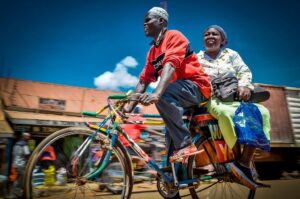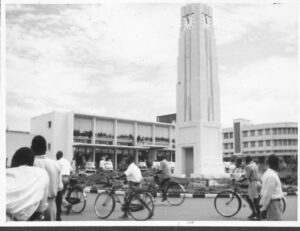
Kisumu on the shore of Lake Victoria and founded in 1901 to serve as the inland terminal for the colonial British Uganda railway, transformed from a trading post to the Kenya’s third largest city and important industrial center. Bicycles were first introduced in Kenya—and Kisumu—by the British colonial government. Colonial officers cycled for their work as local administrators, forest wardens, and agricultural extension workers. Among Africans Kisumu’s migrant agricultural laborers were the first to cycle. Working in plantation system in central Kenya and other areas, they would save up enough to buy luxury goods like bicycles and to bring back home to Kisumu. Since 1950s, cycling spread among African civil servants, who relied on the bicycle for their commute and to get around town. The bicycle became a proud family possession: women used it to do their errands and going to the market. In the process, the bicycle transformed from a commuter vehicle to a means to transport goods.

Since the early 1990s, the bicycle was no longer a status symbol for colonial elites or the new middle classes serving people’s individual mobility to get from A to B. Instead, the bicycle taxis re-emerged to serve as private vehicles to get around the city when the urban public transit could not meet the needs of ordinary people: the so-called boda boda cyclists are taxi drivers who transport people for a fee on a bicycle. Bicycles turned into the popular work horses for people on the fringes of society, who made a living out of transporting people and goods to the market. The thriving bicycle taxi industry provided income for the hundreds of young and middle-aged men pushed out of work when the textile industry collapsed and the fish export market shrunk. In 2001, for the city’s 100-year commemoration, Kenyan musician Suzanne Owiyo captured the imagination and representation of Kisumu’s key symbols when she celebrated the Boda Boda as typical of Kisumu’s street life.
Today the private bicycle taxis are integral to Kisumu’s public transit system. The industry is shaped by local forces and gender norms. In 2013, the Kisumu County Assembly discussed how women should sit on the boda bodas (bicycle and motorcycle taxis) and debated motions on cultural practices. If the proponents had won the day, they would have decreed that women had to follow Luo tradition by “decently” sitting sideways instead of facing the riders.
Dr. Jethron Akallah is researching Kisumu’s history of how bicycle first became the high-status symbol of colonial rule and later for the new middle-class before being utilized to carry goods to the market and moving around people as a taxi service. His overview of Kisumu’s early story as a cycling city and how the bicycle has defined its mobility will be paired with archival documents and interviews with ordinary cyclists and bicycle taxi users to map people’s daily experiences and how bicycles have social spatially been appropriated for public transport. Special attention will be paid to how cycling has been socially and culturally constructed within Kisumu’s predominantly patriarchal society.